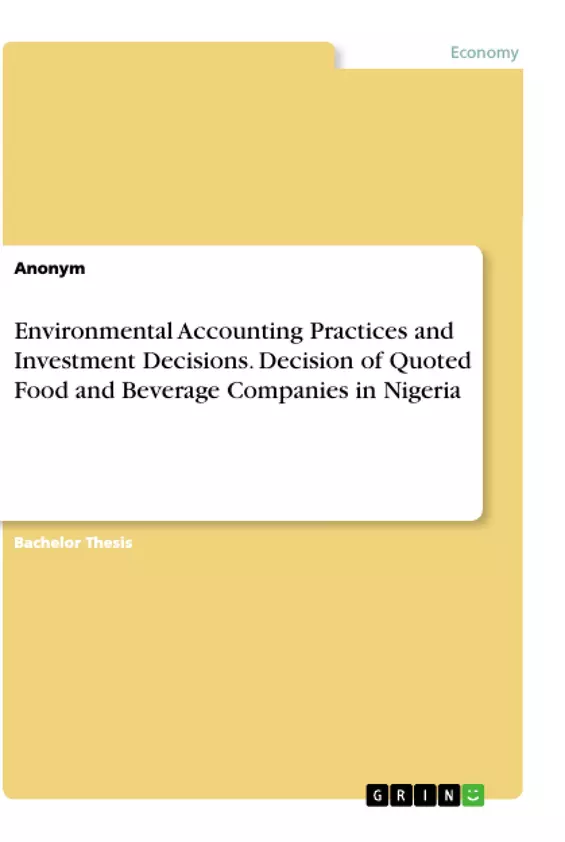This study examines the effect of environmental accounting practices on investment decision of quoted food and beverage companies in Nigeria. The study employed the ex post facto research design. The population consisted of 23 quoted food and beverage companies in Nigeria as at 31st December 2018 according to Nigeria Stock Exchange (NSE). The sample size consisted of 10 food and beverages companies in Nigeria.
It employed the convenience sampling technique in selection of the sampled companies under investigation. Data from the research were obtained from financial statements and annual reports of the sampled companies. Validity and Reliability were premised on statutory audit of the financial statements. Data were analysed through descriptive and inferential statistics.
Investment decisions are as old as man and is now veiled in the mystery of antiquity. The choice is born out of a desire to make way for the future or to plan for rainy days. Under traditional financial theory, investors are called cautious wealth maximizers, adopting basic financial rules and basing their investment decisions solely on risk-return considerations. Studies further revealed that factors are not necessary to influence investment decisions.
Inhaltsverzeichnis (Table of Contents)
- CHAPTER ONE: INTRODUCTION.
- 1.1. Background to the Study.
- 1.2. Statement of the Problem.
- 1.3. Objective of the Study.
- 1.4. Research Questions.
- 1.5. Research Hypotheses.
- 1.6 Justification for the Study.
- 1.7 Significance of the Study.
- 1.8 Scope of the study.
- 1.9. Limitations of the Study.
- 1.10 Operationalization of Variables
- 1.10.1 Mathematical Model
- 1.11 Operational Definition of Terms.
- CHAPTER TWO: REVIEW OF LITERATURE.
- 2.1 Conceptual Review.
- 2.1.1. Environmental Accounting.
- 2.1.2 Environmental Accounting Practices in Nigeria.
- 2.1.3 Environmental Acts and Regulations in Nigeria.
- 2.1.4 Investment Decision
- 2.1.5 Measurement of Investment Decision.
- 2.1.6 Measurement of Environmental Accounting Practices.
- 2.2 Theoretical Review
- 2.2.1 Stakeholders Theory
- 2.2.2 Political Economy Theory
- 2.2.3 Legitimacy Theory.
- 2.2.4 Signaling Theory.
- 2.2.5 Theoretical Framework.
- 2.3 Empirical Review.
- 2.3.1 Environmental Accounting Practices and Market price per share
- 2.3.2 The controlling effect of firm size on the relationship between environmental accounting practices and market price per share.
- 2.3.3 Environmental Accounting Practices and Volume of shares traded.
- 2.3.4 The controlling effect of firm size on the relationship between environmental accounting practices and volume of shares traded
- 2.3.5 Environmental Accounting Practices and Market capitalization.
- 2.3.6 The controlling effect of firm size on the relationship between environmental accounting practices and market capitalization.
- 2.4 Tabular summary of Empirical Findings.
- 2.5 Gap in Literature.
- 2.6 Researcher's Conceptual Framework
- CHAPTER THREE: METHODOLOGY
- 3.1 Research design
- 3.3 Sample size and Sampling technique.
- 3.4 Restatement of hypotheses.
- 3.5 Methods of data collection.
- 3.6 Instrument for Data Collection
- 3.7 Validity and Reliability test.
- 3.8 Administration of Research Instrument
- 3.9 Method of Data Analysis.
- 3.10 Model Specification and Measurement of Variables.
- 3.11 Model Evaluation.
- 3.12 A priori Expectation/Expected Result.
- 3.13 Ethical Consideration.
- CHAPTER FOUR: DATA ANALYSES, RESULTS AND DISCUSSION OF FINDINGS.
- 4.1 Descriptive Statistics
- 4.2 Testing of Hypotheses
- 4.2.1 Test of Hypothesis One (H.1).
- 4.2.2: Test of Hypothesis Two (H。2).
- 4.2.3: Test of Hypothesis Three (H。3).
- 4.2.4: Test of Hypothesis Four (H。4).
- 4.2.5 Testing of Hypothesis Five (H05).
- 4.2.6 Testing of Hypothesis Six.
- 4.3 Discussion of Findings.
- 4.4 Implications of Findings.
Zielsetzung und Themenschwerpunkte (Objectives and Key Themes)
This research aims to investigate the impact of environmental accounting practices on the investment decisions of quoted food and beverage companies in Nigeria. The study utilizes a quantitative approach and analyzes data from financial statements and annual reports of sampled companies.
- The influence of environmental accounting practices on market price per share of quoted food and beverage companies in Nigeria.
- The effect of firm size on the relationship between environmental accounting practices and market price per share.
- The impact of environmental accounting practices on the volume of shares traded by quoted food and beverage companies in Nigeria.
- The effect of firm size on the relationship between environmental accounting practices and volume of shares traded.
- The impact of environmental accounting practices on the market capitalization of quoted food and beverage companies in Nigeria.
Zusammenfassung der Kapitel (Chapter Summaries)
- Chapter One: Introduction introduces the research topic, outlining the background, statement of the problem, research objectives, questions, and hypotheses. It also clarifies the justification, significance, scope, and limitations of the study.
- Chapter Two: Review of Literature provides a comprehensive overview of existing literature on environmental accounting, investment decisions, and related theoretical frameworks. This chapter also includes a critical analysis of previous empirical studies on the relationship between environmental accounting practices and investment decisions.
- Chapter Three: Methodology describes the research design, sample size and selection techniques, data collection methods, and data analysis strategies. The chapter also explains the variables used in the study and the statistical models applied.
- Chapter Four: Data Analyses, Results, and Discussion of Findings presents the descriptive statistics, hypothesis testing, and a detailed discussion of the results. The chapter interprets the findings and relates them to the existing literature.
Schlüsselwörter (Keywords)
The core focus of this study revolves around the connection between environmental accounting practices and investment decisions in the Nigerian food and beverage industry. Key concepts include environmental protection disclosure, firm size, investment decision, market capitalization, and waste management disclosure. The research aims to contribute to the understanding of how environmental performance influences investor behavior and ultimately affects market dynamics within this specific sector.
- Quote paper
- Anonym (Author), 2019, Environmental Accounting Practices and Investment Decisions. Decision of Quoted Food and Beverage Companies in Nigeria, Munich, GRIN Verlag, https://www.grin.com/document/985933



